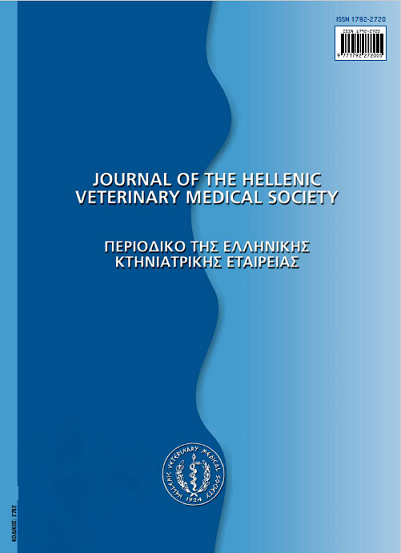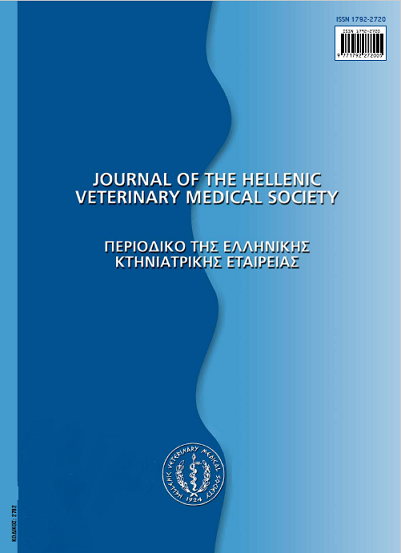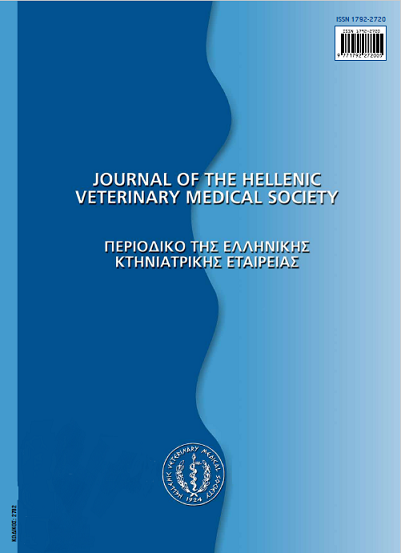Μπορούν να χρησιμοποιηθούν φάρμακα «δεύτερης επιλογής» στη θεραπεία της λεϊσμανίωσης του σκύλου; Το παράδειγμα της αμινοσιδίνης

Περίληψη
Η λεϊσμανιωση εξακολουθεί να αποτελεί ένα από τα συχνότερα νοσήματα του σκύλου στις μεσογειακές χώρες,ενώ παράλληλα είναι και ζωοανθρωπονόσος. Συμφωνά με πρόσφατες δημοσιεύσεις, τα αντιλεϊσμανιακά φάρμακα που χρησιμοποιούνται στη θεραπεία της μπορούν να χωριστούν σε «πρώτης» (αντιμονιακή μεγλουμίνη, αλλοπουρινόλη, συνδυασμός των δυο παραπάνω, αμφοτερικινη Β) και «δεύτερης επιλογής» (αμινοσιδινη, πενταμιδινη, μετρονιδαζόλη σε συνδυασμό με την ενροφλοξασίνη ή τη σπιραμυκινη, μιλτεφοσινη, κετοκοναζόλη). Για την αντικειμενική αξιολόγηση και ταξινόμηση των φαρμάκων αυτών πρέπει να συνυπολογίζονται διάφοροι παράγοντες, όπως είναι η οδός, η δόση, η συχνότητα και η διάρκεια χορήγησης, η κλινική αποτελεσματικότητα, η τοξικότητα, η παρασιτολογική ίαση, η μεταβολή της ανοσολογικής απάντησης του συμπτωματικού σκύλου και η αποτροπή μετάδοσης του πρωτόζωου στους φλεβοτόμους. Όταν δεν διαφέρουν οι υπόλοιπες παράμετροι, η θεραπευτική αντιμετώπιση με φάρμακα που χορηγούνται από το στόμα υπερέχει, επειδή δεν απαιτείται η νοσηλεία του ζώου στηνκλινική και αποφεύγονται οι αντιδράσεις στα σημεία των εγχύσεων. Η δόση του κάθε φαρμάκου πρέπει να προσδιορίζεται υστέρααπό φαρμακοδυναμικές και φαρμακοκινητικές μελέτες, με στόχο τη μεγιστοποίηση της αποτελεσματικότητας, τον περιορισμό της τοξικότητας και την αποφυγή δημιουργίας ανθεκτικών στελεχών του πρωτόζωου. Η κλινική αποτελεσματικότητα καιη ασφάλεια καλό είναι να ελέγχονται με σταδιοποιημένες κλινικές μελέτες, ξεκινώντας από τις τοξικολογικές, συνεχίζοντας μεαπλές μελέτες παρατήρησης και καταλήγοντας σε συγκριτικές μελέτες, στις οποίες οι σκύλοι κατανέμονται τυχαία στις θεραπευτικές ομάδες και οι ερευνητές δεν γνωρίζουν την ομάδα του κάθε ζώου. Δυστυχώς, για αρκετές από τις φαρμακευτικές ουσίες που χρησιμοποιούνται στη θεραπεία της λεϊσμανίωσης του σκύλου οι διαδοχικές αυτές μελέτες δεν έχουν πραγματοποιηθεί, ενώ σε ορισμένες περιπτώσεις έχουν χρησιμοποιηθεί λανθασμένα δοσολογικά σχήματα. Το χαρακτηριστικότερο ίσως παράδειγμα είναι εκείνο της αμινοσιδίνης, η οποία στις συγκριτικές μελέτες χορηγήθηκε σε μη σωστή δόση (5mg/kg Σ.Β.) και συχνότητα (κάθε12 ώρες). Ακόμη και σήμερα δεν επιτυγχάνεται παρασιτολογική ίαση στην πλειονότητα των περιστατικών, ανεξάρτητα από το χρησιμοποιούμενο κάθε φορά θεραπευτικό πρωτόκολλο. Ακόμη, όμως, και στην περίπτωση που θα ήταν εφικτή, δεν θα είχε ιδιαίτερηαξία για τους σκύλους εκείνους που ζουν στις ενδημικές περιοχές λόγω των συνεχών επαναμολΰνσεων. Αντίθετα, ησημασία της μεταβολής της ανοσολογικής ανταπόκρισης του ξενιστή απέναντι στο πρωτόζωο είναι καθοριστική για την αποφυγήτων υποτροπών μετά το τέλος της θεραπείας. Τέλος, η πιθανότητα μόλυνσης των φλεβοτόμων μειώνεται χωρίς όμως να μηδενίζεται,τουλάχιστον με τα θεραπευτικά πρωτόκολλα που έχουν ελεγχθεί μέχρι σήμερα. Αν και το γεγονός αυτό δεν φαίνεται να έχει ιδιαίτερη σημασία από επιζωτιολογική άποψη, θα μπορούσε να ενέχει τον κίνδυνο εξάπλωσης των ανθεκτικών στελεχών του πρωτόζωου. Το επιστημονικά σωστό δοσολογικό σχήμα, η χρησιμοποίηση διαφορετικού φαρμάκου σε περίπτωση υποτροπής, ο συνδυασμός ουσιών που έχουν διαφορετικό μηχανισμό δράσης και η κατά το δυνατό αποφυγή των φαρμάκων εκείνων που χρησιμοποιούνται στη σπλαγχνική λεϊσμανιωση του ανθρώπου, έχουν προταθεί ως μέτρα που θα μπορούσαν να μειώσουν ή να καθυστερήσουν τη δημιουργία ανθεκτικών στελεχών. Η αμινοσιδινη έχει από τη φύση της δυο βασικά μειονεκτήματα, αφού χορηγείται παρεντερικώς και αντενδείκνυται σε σκύλους με νεφρική ανεπάρκεια. Ωστόσο, έχει και αρκετά πλεονεκτήματα, όπως είναι το μικρό κόστος, η διάθεση της στο εμπόριο, η χορήγηση μια φορά την ημέρα, το ικανοποιητικό κλινικό αποτέλεσμα και η ασφάλεια στο σωστό δοσολογικό σχήμα και το γεγονός ότι στις μεσογειακές χώρες δεν χρησιμοποιείται στη θεραπευτική αντιμετώπιση της σπλαγχνικής λεϊσμανίωσης του ανθρώπου. Για τους παραπάνω λόγους, και προκειμένου να αποδειχθεί, πέρααπό κάθε αμφιβολία, το κατά πόσο θα πρέπει να θεωρείται ή όχι ουσία «πρώτης επιλογής» για τη θεραπεία της λεϊσμανίωσης του σκύλου, είναι απαραίτητο να γίνουν σωστά σχεδιασμένες συγκριτικές μελέτες.
Λεπτομέρειες άρθρου
- Πώς να δημιουργήσετε Αναφορές
-
SARIDOMICHELAKIS (Μ. Ν. ΣΑΡΙΔΟΜΙΧΕΛΑΚΗΣ) N. M., ATHANASIOU (Λ. ΑΘΑΝΑΣΙΟΥ) V. L., & KASABALIS (Δ. ΚΑΣΑΜΠΑΛΗΣ) D. (2017). Μπορούν να χρησιμοποιηθούν φάρμακα «δεύτερης επιλογής» στη θεραπεία της λεϊσμανίωσης του σκύλου; Το παράδειγμα της αμινοσιδίνης. Περιοδικό της Ελληνικής Κτηνιατρικής Εταιρείας, 59(3), 239–246. https://doi.org/10.12681/jhvms.14961
- Τεύχος
- Τόμ. 59 Αρ. 3 (2008)
- Ενότητα
- Review Articles
Οι συγγραφείς των άρθρων που δημοσιεύονται στο περιοδικό διατηρούν τα δικαιώματα πνευματικής ιδιοκτησίας επί των άρθρων τους, δίνοντας στο περιοδικό το δικαίωμα της πρώτης δημοσίευσης.
Άρθρα που δημοσιεύονται στο περιοδικό διατίθενται με άδεια Creative Commons 4.0 Non Commercial και σύμφωνα με την άδεια μπορούν να χρησιμοποιούνται ελεύθερα, με αναφορά στο/στη συγγραφέα και στην πρώτη δημοσίευση για μη κερδοσκοπικούς σκοπούς.
Οι συγγραφείς μπορούν να καταθέσουν το άρθρο σε ιδρυματικό ή άλλο αποθετήριο ή/και να το δημοσιεύσουν σε άλλη έκδοση, με υποχρεωτική την αναφορά πρώτης δημοσίευσης στο J Hellenic Vet Med Soc
Οι συγγραφείς ενθαρρύνονται να καταθέσουν σε αποθετήριο ή να δημοσιεύσουν την εργασία τους στο διαδίκτυο πριν ή κατά τη διαδικασία υποβολής και αξιολόγησής της.








